Knowledge Management with Social Media: Analysis of Strategies
VerifiedAdded on 2020/05/04
|13
|3229
|85
Essay
AI Summary
This essay examines the critical role of social media in knowledge management within multinational corporations (MNCs) and small to medium-sized enterprises (SMEs). It explores how social media platforms, such as Facebook, Twitter, and LinkedIn, facilitate knowledge sharing, building social capital, and supporting innovation. The essay delves into the SECI model (Socialization, Externalization, Combination, and Internalization) and its application in knowledge creation and management. It analyzes how MNCs leverage social media to enhance internal knowledge, foster relationships, and address business challenges. Furthermore, the essay discusses the benefits and risks associated with adopting social media strategies, including aiding problem-solving and driving business growth in competitive markets. The examples of companies like NDIVIA, SingTel, ORACLE, and KINDLE are used to illustrate the practical application of these concepts. The essay also touches on the impact of social media on building social capital, supporting innovation, and aiding in problem-solving within organizations, highlighting the importance of adapting organizational culture to facilitate knowledge sharing and leverage social media for strategic advantage.
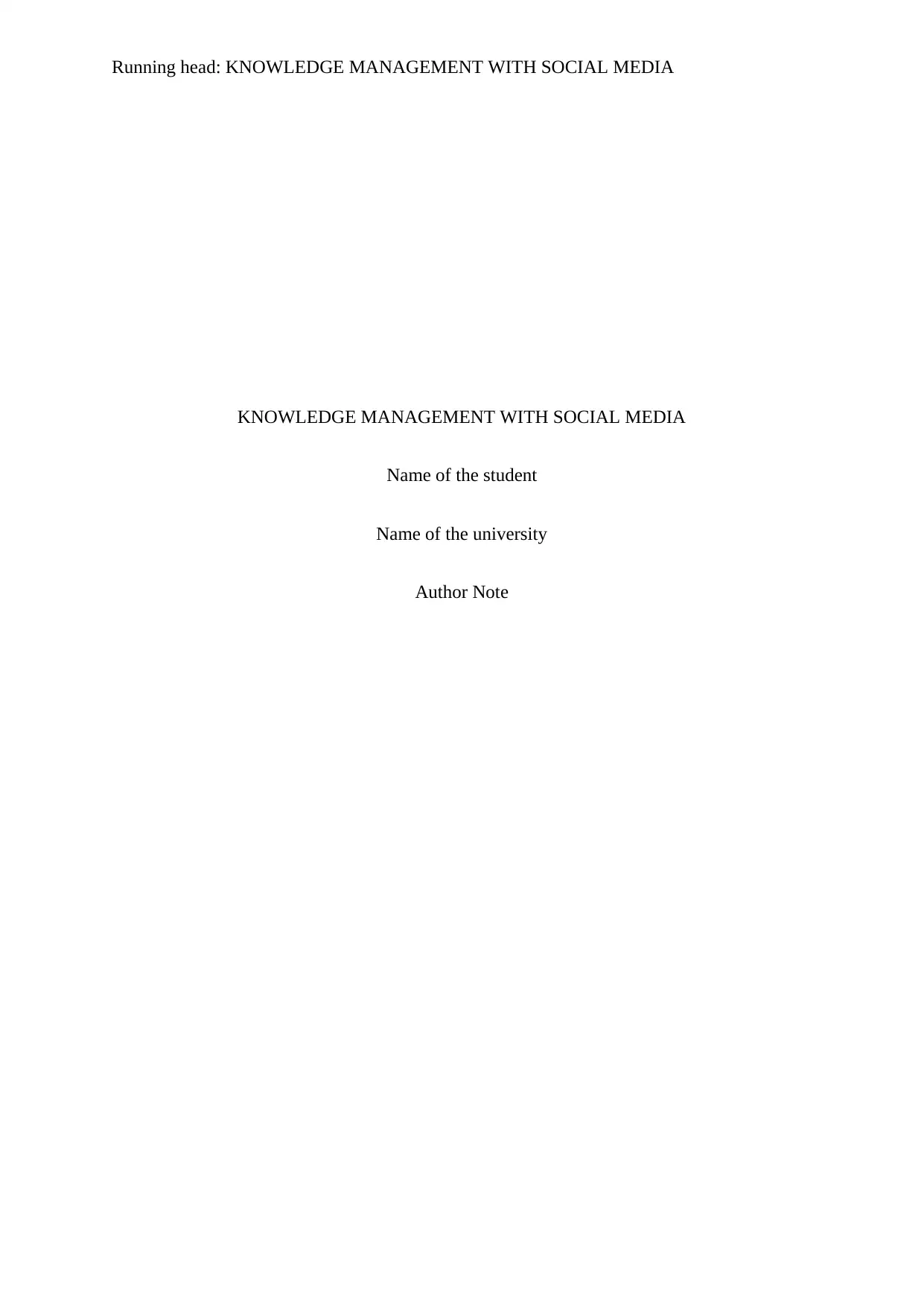
Running head: KNOWLEDGE MANAGEMENT WITH SOCIAL MEDIA
KNOWLEDGE MANAGEMENT WITH SOCIAL MEDIA
Name of the student
Name of the university
Author Note
KNOWLEDGE MANAGEMENT WITH SOCIAL MEDIA
Name of the student
Name of the university
Author Note
Paraphrase This Document
Need a fresh take? Get an instant paraphrase of this document with our AI Paraphraser
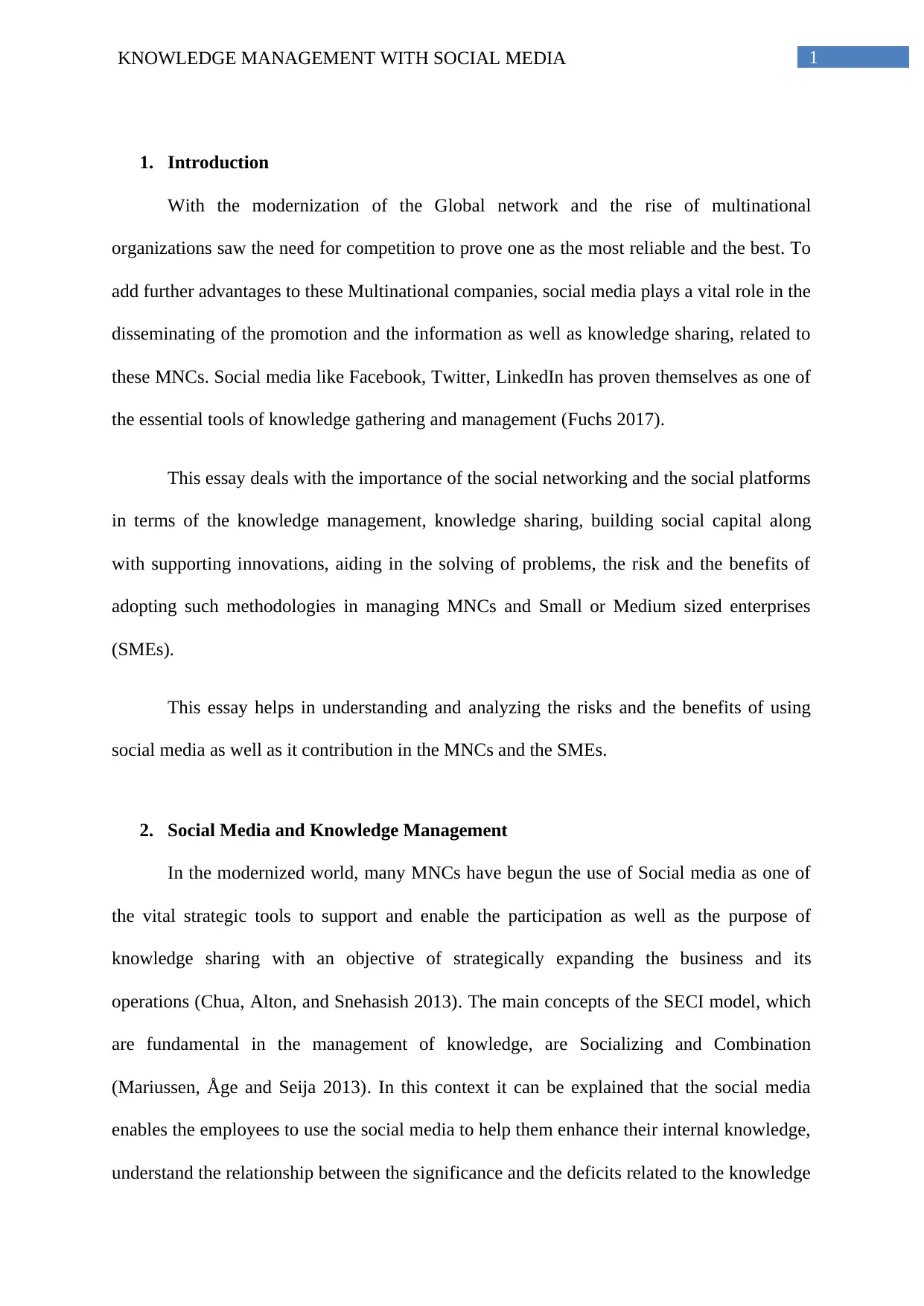
1KNOWLEDGE MANAGEMENT WITH SOCIAL MEDIA
1. Introduction
With the modernization of the Global network and the rise of multinational
organizations saw the need for competition to prove one as the most reliable and the best. To
add further advantages to these Multinational companies, social media plays a vital role in the
disseminating of the promotion and the information as well as knowledge sharing, related to
these MNCs. Social media like Facebook, Twitter, LinkedIn has proven themselves as one of
the essential tools of knowledge gathering and management (Fuchs 2017).
This essay deals with the importance of the social networking and the social platforms
in terms of the knowledge management, knowledge sharing, building social capital along
with supporting innovations, aiding in the solving of problems, the risk and the benefits of
adopting such methodologies in managing MNCs and Small or Medium sized enterprises
(SMEs).
This essay helps in understanding and analyzing the risks and the benefits of using
social media as well as it contribution in the MNCs and the SMEs.
2. Social Media and Knowledge Management
In the modernized world, many MNCs have begun the use of Social media as one of
the vital strategic tools to support and enable the participation as well as the purpose of
knowledge sharing with an objective of strategically expanding the business and its
operations (Chua, Alton, and Snehasish 2013). The main concepts of the SECI model, which
are fundamental in the management of knowledge, are Socializing and Combination
(Mariussen, Åge and Seija 2013). In this context it can be explained that the social media
enables the employees to use the social media to help them enhance their internal knowledge,
understand the relationship between the significance and the deficits related to the knowledge
1. Introduction
With the modernization of the Global network and the rise of multinational
organizations saw the need for competition to prove one as the most reliable and the best. To
add further advantages to these Multinational companies, social media plays a vital role in the
disseminating of the promotion and the information as well as knowledge sharing, related to
these MNCs. Social media like Facebook, Twitter, LinkedIn has proven themselves as one of
the essential tools of knowledge gathering and management (Fuchs 2017).
This essay deals with the importance of the social networking and the social platforms
in terms of the knowledge management, knowledge sharing, building social capital along
with supporting innovations, aiding in the solving of problems, the risk and the benefits of
adopting such methodologies in managing MNCs and Small or Medium sized enterprises
(SMEs).
This essay helps in understanding and analyzing the risks and the benefits of using
social media as well as it contribution in the MNCs and the SMEs.
2. Social Media and Knowledge Management
In the modernized world, many MNCs have begun the use of Social media as one of
the vital strategic tools to support and enable the participation as well as the purpose of
knowledge sharing with an objective of strategically expanding the business and its
operations (Chua, Alton, and Snehasish 2013). The main concepts of the SECI model, which
are fundamental in the management of knowledge, are Socializing and Combination
(Mariussen, Åge and Seija 2013). In this context it can be explained that the social media
enables the employees to use the social media to help them enhance their internal knowledge,
understand the relationship between the significance and the deficits related to the knowledge
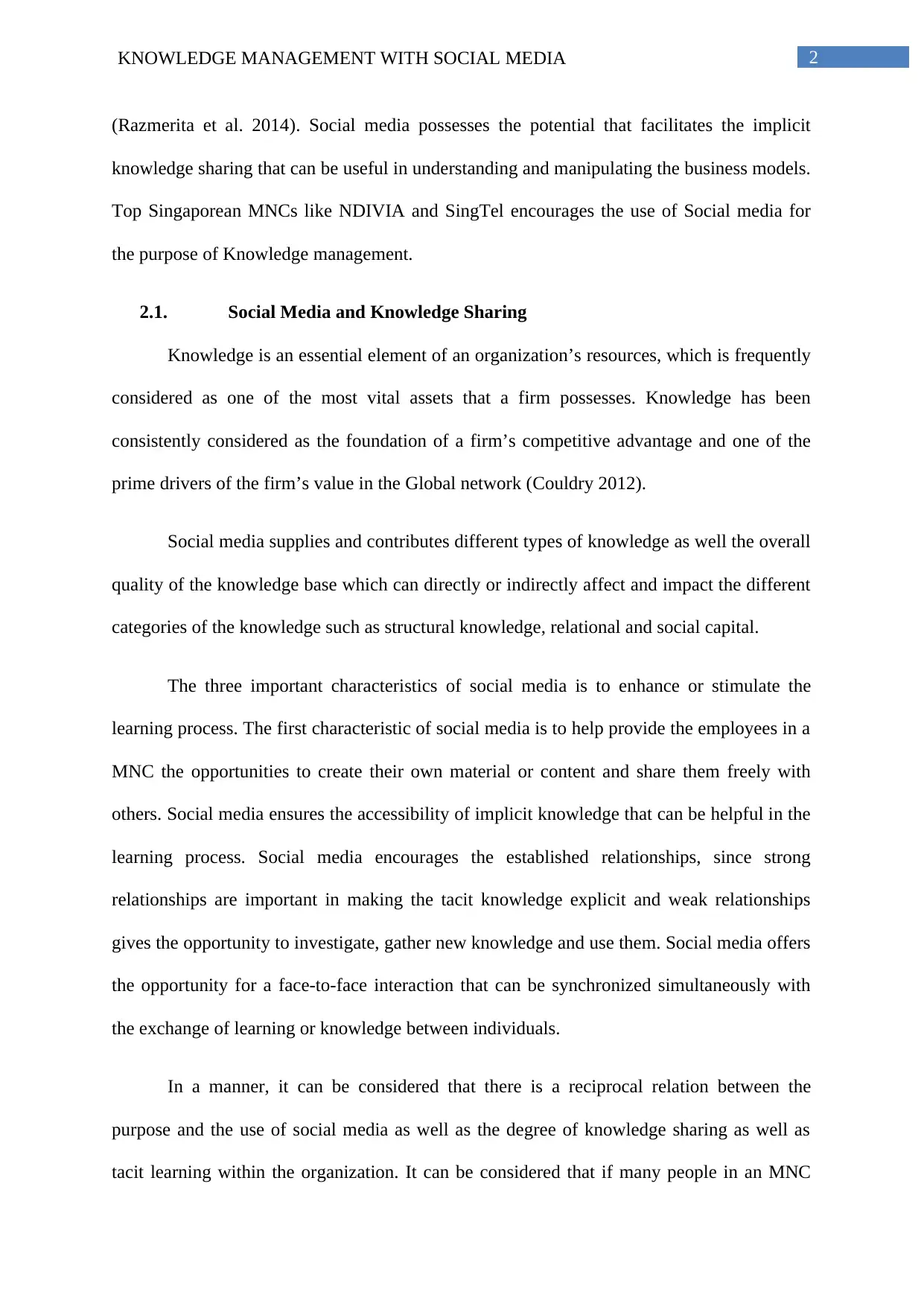
2KNOWLEDGE MANAGEMENT WITH SOCIAL MEDIA
(Razmerita et al. 2014). Social media possesses the potential that facilitates the implicit
knowledge sharing that can be useful in understanding and manipulating the business models.
Top Singaporean MNCs like NDIVIA and SingTel encourages the use of Social media for
the purpose of Knowledge management.
2.1. Social Media and Knowledge Sharing
Knowledge is an essential element of an organization’s resources, which is frequently
considered as one of the most vital assets that a firm possesses. Knowledge has been
consistently considered as the foundation of a firm’s competitive advantage and one of the
prime drivers of the firm’s value in the Global network (Couldry 2012).
Social media supplies and contributes different types of knowledge as well the overall
quality of the knowledge base which can directly or indirectly affect and impact the different
categories of the knowledge such as structural knowledge, relational and social capital.
The three important characteristics of social media is to enhance or stimulate the
learning process. The first characteristic of social media is to help provide the employees in a
MNC the opportunities to create their own material or content and share them freely with
others. Social media ensures the accessibility of implicit knowledge that can be helpful in the
learning process. Social media encourages the established relationships, since strong
relationships are important in making the tacit knowledge explicit and weak relationships
gives the opportunity to investigate, gather new knowledge and use them. Social media offers
the opportunity for a face-to-face interaction that can be synchronized simultaneously with
the exchange of learning or knowledge between individuals.
In a manner, it can be considered that there is a reciprocal relation between the
purpose and the use of social media as well as the degree of knowledge sharing as well as
tacit learning within the organization. It can be considered that if many people in an MNC
(Razmerita et al. 2014). Social media possesses the potential that facilitates the implicit
knowledge sharing that can be useful in understanding and manipulating the business models.
Top Singaporean MNCs like NDIVIA and SingTel encourages the use of Social media for
the purpose of Knowledge management.
2.1. Social Media and Knowledge Sharing
Knowledge is an essential element of an organization’s resources, which is frequently
considered as one of the most vital assets that a firm possesses. Knowledge has been
consistently considered as the foundation of a firm’s competitive advantage and one of the
prime drivers of the firm’s value in the Global network (Couldry 2012).
Social media supplies and contributes different types of knowledge as well the overall
quality of the knowledge base which can directly or indirectly affect and impact the different
categories of the knowledge such as structural knowledge, relational and social capital.
The three important characteristics of social media is to enhance or stimulate the
learning process. The first characteristic of social media is to help provide the employees in a
MNC the opportunities to create their own material or content and share them freely with
others. Social media ensures the accessibility of implicit knowledge that can be helpful in the
learning process. Social media encourages the established relationships, since strong
relationships are important in making the tacit knowledge explicit and weak relationships
gives the opportunity to investigate, gather new knowledge and use them. Social media offers
the opportunity for a face-to-face interaction that can be synchronized simultaneously with
the exchange of learning or knowledge between individuals.
In a manner, it can be considered that there is a reciprocal relation between the
purpose and the use of social media as well as the degree of knowledge sharing as well as
tacit learning within the organization. It can be considered that if many people in an MNC
⊘ This is a preview!⊘
Do you want full access?
Subscribe today to unlock all pages.

Trusted by 1+ million students worldwide
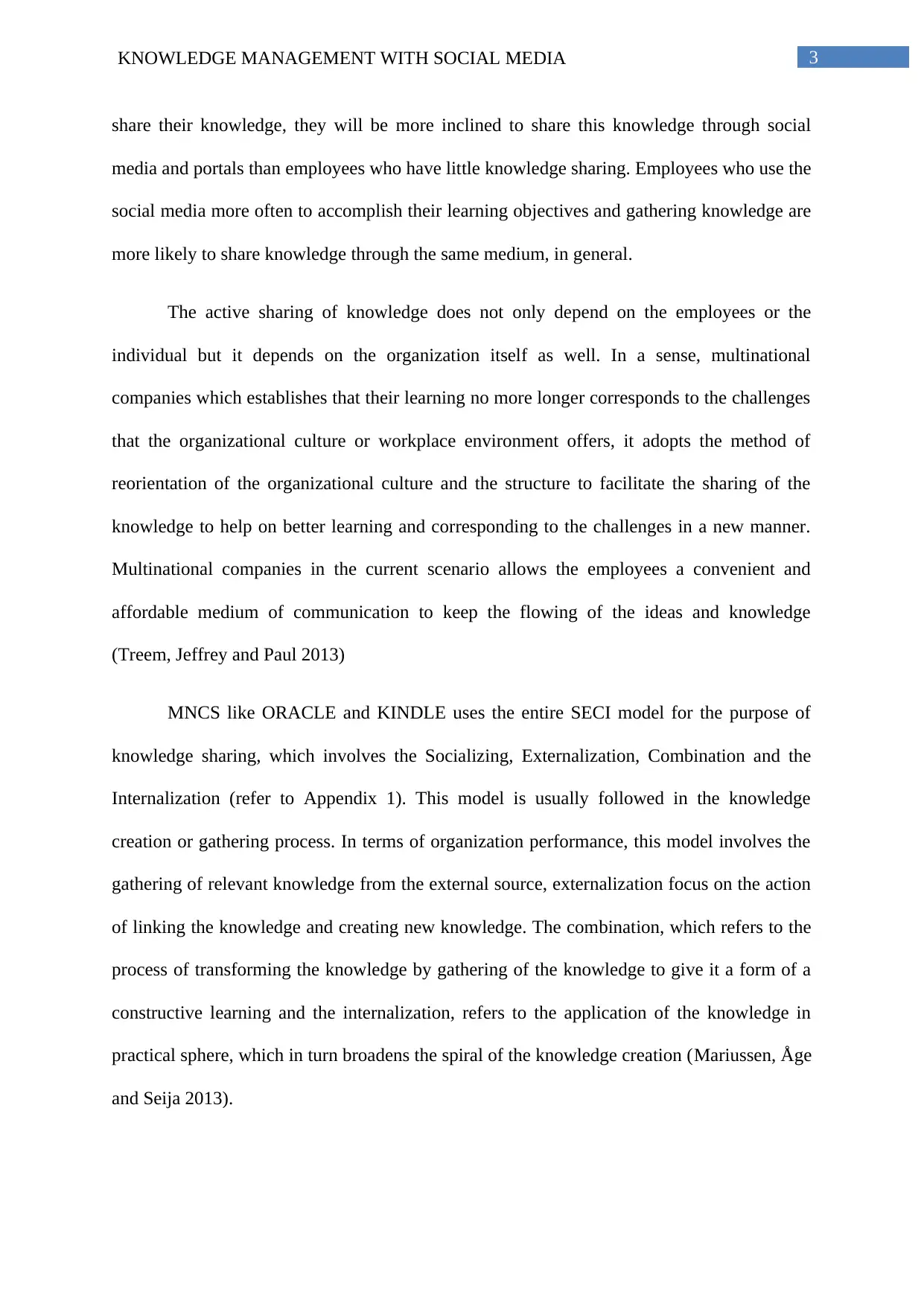
3KNOWLEDGE MANAGEMENT WITH SOCIAL MEDIA
share their knowledge, they will be more inclined to share this knowledge through social
media and portals than employees who have little knowledge sharing. Employees who use the
social media more often to accomplish their learning objectives and gathering knowledge are
more likely to share knowledge through the same medium, in general.
The active sharing of knowledge does not only depend on the employees or the
individual but it depends on the organization itself as well. In a sense, multinational
companies which establishes that their learning no more longer corresponds to the challenges
that the organizational culture or workplace environment offers, it adopts the method of
reorientation of the organizational culture and the structure to facilitate the sharing of the
knowledge to help on better learning and corresponding to the challenges in a new manner.
Multinational companies in the current scenario allows the employees a convenient and
affordable medium of communication to keep the flowing of the ideas and knowledge
(Treem, Jeffrey and Paul 2013)
MNCS like ORACLE and KINDLE uses the entire SECI model for the purpose of
knowledge sharing, which involves the Socializing, Externalization, Combination and the
Internalization (refer to Appendix 1). This model is usually followed in the knowledge
creation or gathering process. In terms of organization performance, this model involves the
gathering of relevant knowledge from the external source, externalization focus on the action
of linking the knowledge and creating new knowledge. The combination, which refers to the
process of transforming the knowledge by gathering of the knowledge to give it a form of a
constructive learning and the internalization, refers to the application of the knowledge in
practical sphere, which in turn broadens the spiral of the knowledge creation (Mariussen, Åge
and Seija 2013).
share their knowledge, they will be more inclined to share this knowledge through social
media and portals than employees who have little knowledge sharing. Employees who use the
social media more often to accomplish their learning objectives and gathering knowledge are
more likely to share knowledge through the same medium, in general.
The active sharing of knowledge does not only depend on the employees or the
individual but it depends on the organization itself as well. In a sense, multinational
companies which establishes that their learning no more longer corresponds to the challenges
that the organizational culture or workplace environment offers, it adopts the method of
reorientation of the organizational culture and the structure to facilitate the sharing of the
knowledge to help on better learning and corresponding to the challenges in a new manner.
Multinational companies in the current scenario allows the employees a convenient and
affordable medium of communication to keep the flowing of the ideas and knowledge
(Treem, Jeffrey and Paul 2013)
MNCS like ORACLE and KINDLE uses the entire SECI model for the purpose of
knowledge sharing, which involves the Socializing, Externalization, Combination and the
Internalization (refer to Appendix 1). This model is usually followed in the knowledge
creation or gathering process. In terms of organization performance, this model involves the
gathering of relevant knowledge from the external source, externalization focus on the action
of linking the knowledge and creating new knowledge. The combination, which refers to the
process of transforming the knowledge by gathering of the knowledge to give it a form of a
constructive learning and the internalization, refers to the application of the knowledge in
practical sphere, which in turn broadens the spiral of the knowledge creation (Mariussen, Åge
and Seija 2013).
Paraphrase This Document
Need a fresh take? Get an instant paraphrase of this document with our AI Paraphraser

4KNOWLEDGE MANAGEMENT WITH SOCIAL MEDIA
2.2. Social Media and Building Social Capital
In the increasingly competitive world, the essence of knowledge gathering and
building social capital ensures the multinational organizations to achieve higher competitive
advantages and thrive well in the market. The competition comes in form of various ways,
which could be either in form of introducing a new piece of technology or investment in the
research and the development (Leftheriotis and Michail 2014).
Social capital is referred to the functions of network relationships between an
individual and one or more social interaction groups. In terms of sociology, social capital is
more commonly refers to the capability of the group members to get the things done, whether
be it raising funds for a charity, selling some new product or hiring a new member for the
organization. In terms of building the social capital trust and generalized helping along with
the social norms builds up the social capital.
Within the MNCs, the social capital is considered as the belonging to the individuals
or small groups who utilize this capital in order to accomplish their objectives. For instance,
employees who help in promoting the innovations within a company are considered to
accomplish this task through effective utilization of social capital.
With reference to the social capital, the MNCs encourages its employees to acquire
social capital through actions within the organization, such as supporting members of the
organization, providing valuable resources to the organization, such as information or time,
or through building friendships within the group which could be influential in solving
complicated issues and concerns.
Major Multinational Corporations like MEC and Sky scanner, uses the socializing,
combination and the internalization concepts of the SECI model that in turn utilizes the social
media and other online platforms to generate the social capital. This is achieved by the
2.2. Social Media and Building Social Capital
In the increasingly competitive world, the essence of knowledge gathering and
building social capital ensures the multinational organizations to achieve higher competitive
advantages and thrive well in the market. The competition comes in form of various ways,
which could be either in form of introducing a new piece of technology or investment in the
research and the development (Leftheriotis and Michail 2014).
Social capital is referred to the functions of network relationships between an
individual and one or more social interaction groups. In terms of sociology, social capital is
more commonly refers to the capability of the group members to get the things done, whether
be it raising funds for a charity, selling some new product or hiring a new member for the
organization. In terms of building the social capital trust and generalized helping along with
the social norms builds up the social capital.
Within the MNCs, the social capital is considered as the belonging to the individuals
or small groups who utilize this capital in order to accomplish their objectives. For instance,
employees who help in promoting the innovations within a company are considered to
accomplish this task through effective utilization of social capital.
With reference to the social capital, the MNCs encourages its employees to acquire
social capital through actions within the organization, such as supporting members of the
organization, providing valuable resources to the organization, such as information or time,
or through building friendships within the group which could be influential in solving
complicated issues and concerns.
Major Multinational Corporations like MEC and Sky scanner, uses the socializing,
combination and the internalization concepts of the SECI model that in turn utilizes the social
media and other online platforms to generate the social capital. This is achieved by the
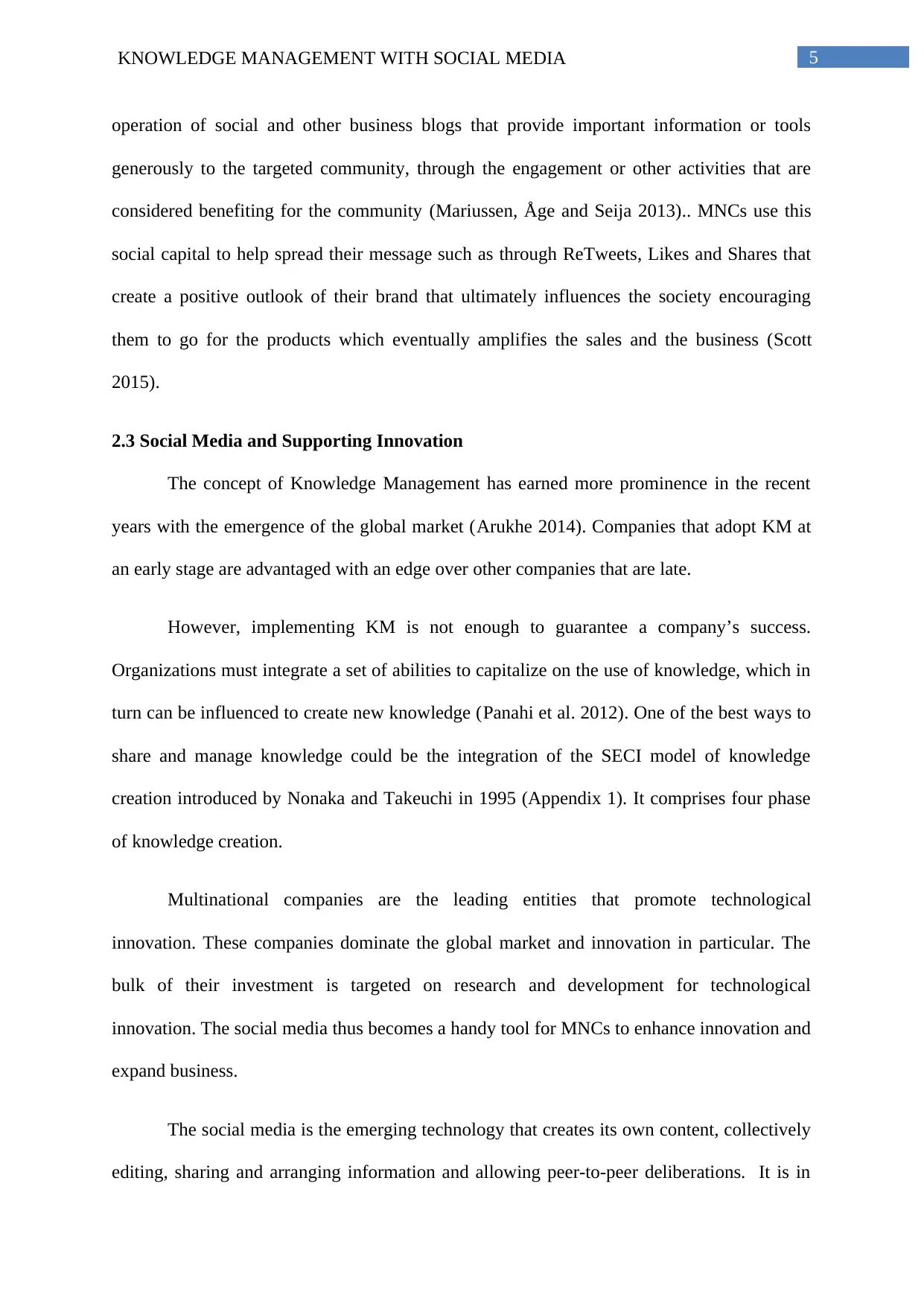
5KNOWLEDGE MANAGEMENT WITH SOCIAL MEDIA
operation of social and other business blogs that provide important information or tools
generously to the targeted community, through the engagement or other activities that are
considered benefiting for the community (Mariussen, Åge and Seija 2013).. MNCs use this
social capital to help spread their message such as through ReTweets, Likes and Shares that
create a positive outlook of their brand that ultimately influences the society encouraging
them to go for the products which eventually amplifies the sales and the business (Scott
2015).
2.3 Social Media and Supporting Innovation
The concept of Knowledge Management has earned more prominence in the recent
years with the emergence of the global market (Arukhe 2014). Companies that adopt KM at
an early stage are advantaged with an edge over other companies that are late.
However, implementing KM is not enough to guarantee a company’s success.
Organizations must integrate a set of abilities to capitalize on the use of knowledge, which in
turn can be influenced to create new knowledge (Panahi et al. 2012). One of the best ways to
share and manage knowledge could be the integration of the SECI model of knowledge
creation introduced by Nonaka and Takeuchi in 1995 (Appendix 1). It comprises four phase
of knowledge creation.
Multinational companies are the leading entities that promote technological
innovation. These companies dominate the global market and innovation in particular. The
bulk of their investment is targeted on research and development for technological
innovation. The social media thus becomes a handy tool for MNCs to enhance innovation and
expand business.
The social media is the emerging technology that creates its own content, collectively
editing, sharing and arranging information and allowing peer-to-peer deliberations. It is in
operation of social and other business blogs that provide important information or tools
generously to the targeted community, through the engagement or other activities that are
considered benefiting for the community (Mariussen, Åge and Seija 2013).. MNCs use this
social capital to help spread their message such as through ReTweets, Likes and Shares that
create a positive outlook of their brand that ultimately influences the society encouraging
them to go for the products which eventually amplifies the sales and the business (Scott
2015).
2.3 Social Media and Supporting Innovation
The concept of Knowledge Management has earned more prominence in the recent
years with the emergence of the global market (Arukhe 2014). Companies that adopt KM at
an early stage are advantaged with an edge over other companies that are late.
However, implementing KM is not enough to guarantee a company’s success.
Organizations must integrate a set of abilities to capitalize on the use of knowledge, which in
turn can be influenced to create new knowledge (Panahi et al. 2012). One of the best ways to
share and manage knowledge could be the integration of the SECI model of knowledge
creation introduced by Nonaka and Takeuchi in 1995 (Appendix 1). It comprises four phase
of knowledge creation.
Multinational companies are the leading entities that promote technological
innovation. These companies dominate the global market and innovation in particular. The
bulk of their investment is targeted on research and development for technological
innovation. The social media thus becomes a handy tool for MNCs to enhance innovation and
expand business.
The social media is the emerging technology that creates its own content, collectively
editing, sharing and arranging information and allowing peer-to-peer deliberations. It is in
⊘ This is a preview!⊘
Do you want full access?
Subscribe today to unlock all pages.

Trusted by 1+ million students worldwide
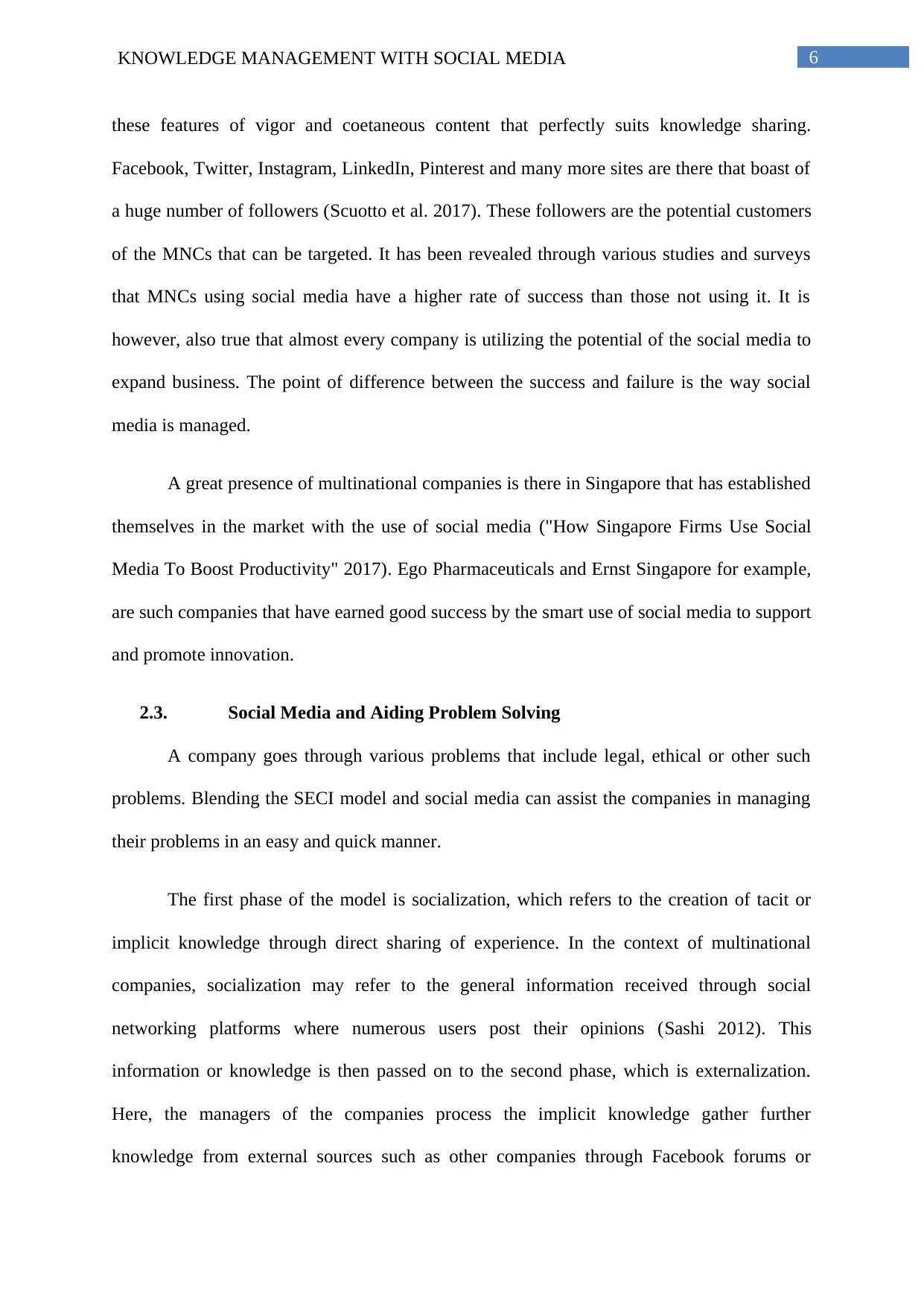
6KNOWLEDGE MANAGEMENT WITH SOCIAL MEDIA
these features of vigor and coetaneous content that perfectly suits knowledge sharing.
Facebook, Twitter, Instagram, LinkedIn, Pinterest and many more sites are there that boast of
a huge number of followers (Scuotto et al. 2017). These followers are the potential customers
of the MNCs that can be targeted. It has been revealed through various studies and surveys
that MNCs using social media have a higher rate of success than those not using it. It is
however, also true that almost every company is utilizing the potential of the social media to
expand business. The point of difference between the success and failure is the way social
media is managed.
A great presence of multinational companies is there in Singapore that has established
themselves in the market with the use of social media ("How Singapore Firms Use Social
Media To Boost Productivity" 2017). Ego Pharmaceuticals and Ernst Singapore for example,
are such companies that have earned good success by the smart use of social media to support
and promote innovation.
2.3. Social Media and Aiding Problem Solving
A company goes through various problems that include legal, ethical or other such
problems. Blending the SECI model and social media can assist the companies in managing
their problems in an easy and quick manner.
The first phase of the model is socialization, which refers to the creation of tacit or
implicit knowledge through direct sharing of experience. In the context of multinational
companies, socialization may refer to the general information received through social
networking platforms where numerous users post their opinions (Sashi 2012). This
information or knowledge is then passed on to the second phase, which is externalization.
Here, the managers of the companies process the implicit knowledge gather further
knowledge from external sources such as other companies through Facebook forums or
these features of vigor and coetaneous content that perfectly suits knowledge sharing.
Facebook, Twitter, Instagram, LinkedIn, Pinterest and many more sites are there that boast of
a huge number of followers (Scuotto et al. 2017). These followers are the potential customers
of the MNCs that can be targeted. It has been revealed through various studies and surveys
that MNCs using social media have a higher rate of success than those not using it. It is
however, also true that almost every company is utilizing the potential of the social media to
expand business. The point of difference between the success and failure is the way social
media is managed.
A great presence of multinational companies is there in Singapore that has established
themselves in the market with the use of social media ("How Singapore Firms Use Social
Media To Boost Productivity" 2017). Ego Pharmaceuticals and Ernst Singapore for example,
are such companies that have earned good success by the smart use of social media to support
and promote innovation.
2.3. Social Media and Aiding Problem Solving
A company goes through various problems that include legal, ethical or other such
problems. Blending the SECI model and social media can assist the companies in managing
their problems in an easy and quick manner.
The first phase of the model is socialization, which refers to the creation of tacit or
implicit knowledge through direct sharing of experience. In the context of multinational
companies, socialization may refer to the general information received through social
networking platforms where numerous users post their opinions (Sashi 2012). This
information or knowledge is then passed on to the second phase, which is externalization.
Here, the managers of the companies process the implicit knowledge gather further
knowledge from external sources such as other companies through Facebook forums or
Paraphrase This Document
Need a fresh take? Get an instant paraphrase of this document with our AI Paraphraser

7KNOWLEDGE MANAGEMENT WITH SOCIAL MEDIA
Twitter hash tags to know how those companies tackle with problems and try to combine it
with the implicit knowledge thus forming a new knowledge. In the third phase, which is
combination, companies organize the implicit and explicit knowledge systematically and
implement it on an experimental level to analyze if it is feasible to solve problems. Lastly, in
the internalization phase, MNCs learn about the strategies and plans proposed by the internal
elements that is the employees, to solve the problem facing them (Treem, Jeffrey and
Leonardi et al. 2013). Through social groups on apps like WhatsApp or on company groups
formed on Facebook, employees together discuss the possible reasons and causes of the
problem, examine the implicit and explicit knowledge and then propose a concrete solution.
Instances from Singapore’s stiff market competition and the way certain companies
made use of the social media to its full potential prove the effectiveness of the medium.
Wacoal Singapore, a lingerie company faced problems when in 2012, the government
introduced stricter laws related to lingerie ads in public places. The company launched a
campaign on Facebook for iPant, one of its many products that offered good deals to users
who clicked through ads on Facebook. This resulted in the rise of fans and customers of the
company and that too at a low cost.
Another company used similar tactics to resolve issues related to the problem of stiff
competition in the market. Home-Fix Singapore, a home solution provider reinvented its plan
to go ahead in the race and created a Facebook page with maximized contents. The page had
information about simple tricks through which customers can easily maintain their homes
without expending heavily on repairs. The result was that the company extended its business
and opened Home-fix Experience Center that held workshops and activities related to home
solutions ("How Singapore Firms Use Social Media To Boost Productivity" 2017).
Twitter hash tags to know how those companies tackle with problems and try to combine it
with the implicit knowledge thus forming a new knowledge. In the third phase, which is
combination, companies organize the implicit and explicit knowledge systematically and
implement it on an experimental level to analyze if it is feasible to solve problems. Lastly, in
the internalization phase, MNCs learn about the strategies and plans proposed by the internal
elements that is the employees, to solve the problem facing them (Treem, Jeffrey and
Leonardi et al. 2013). Through social groups on apps like WhatsApp or on company groups
formed on Facebook, employees together discuss the possible reasons and causes of the
problem, examine the implicit and explicit knowledge and then propose a concrete solution.
Instances from Singapore’s stiff market competition and the way certain companies
made use of the social media to its full potential prove the effectiveness of the medium.
Wacoal Singapore, a lingerie company faced problems when in 2012, the government
introduced stricter laws related to lingerie ads in public places. The company launched a
campaign on Facebook for iPant, one of its many products that offered good deals to users
who clicked through ads on Facebook. This resulted in the rise of fans and customers of the
company and that too at a low cost.
Another company used similar tactics to resolve issues related to the problem of stiff
competition in the market. Home-Fix Singapore, a home solution provider reinvented its plan
to go ahead in the race and created a Facebook page with maximized contents. The page had
information about simple tricks through which customers can easily maintain their homes
without expending heavily on repairs. The result was that the company extended its business
and opened Home-fix Experience Center that held workshops and activities related to home
solutions ("How Singapore Firms Use Social Media To Boost Productivity" 2017).

8KNOWLEDGE MANAGEMENT WITH SOCIAL MEDIA
2.5. Risks and Benefits of Social Media
2.5.1. Risks
Social media are vulnerable to hacking and employees of any company can be hacked
because of their trust on members of a particular group on social media. Fraudulent activities
also pose a threat to the use of social media for business
Abiding by the privacy laws, ownership of the content, intellectual assets violation and
unlawful activities like harassment, denigration and discrimination are some of the legal risks
that social media pose to companies ("Forbes Welcome" 2017).
Other risks include data collection, operational risks, reputational risks, cost related
risks and so on.
2.5.2. Benefits
Companies nowadays make use of the social media platform to increase brand value.
Facebook, Twitter, Instagram, LinkedIn together have users that could add up to the
formation of a country. Promoting brands in these platforms thus inevitably enhances
recognition ("Forbes Welcome" 2017).
Posting an ad or an update in social platform requires minimum cost but ensures
maximum effectiveness.
The humanization element is another significant advantage of using social media.
Brands in social media act like people and interact directly with the customers.
Social media also increases brand loyalty as more people recognize the brand and
share it with others.
2.5. Risks and Benefits of Social Media
2.5.1. Risks
Social media are vulnerable to hacking and employees of any company can be hacked
because of their trust on members of a particular group on social media. Fraudulent activities
also pose a threat to the use of social media for business
Abiding by the privacy laws, ownership of the content, intellectual assets violation and
unlawful activities like harassment, denigration and discrimination are some of the legal risks
that social media pose to companies ("Forbes Welcome" 2017).
Other risks include data collection, operational risks, reputational risks, cost related
risks and so on.
2.5.2. Benefits
Companies nowadays make use of the social media platform to increase brand value.
Facebook, Twitter, Instagram, LinkedIn together have users that could add up to the
formation of a country. Promoting brands in these platforms thus inevitably enhances
recognition ("Forbes Welcome" 2017).
Posting an ad or an update in social platform requires minimum cost but ensures
maximum effectiveness.
The humanization element is another significant advantage of using social media.
Brands in social media act like people and interact directly with the customers.
Social media also increases brand loyalty as more people recognize the brand and
share it with others.
⊘ This is a preview!⊘
Do you want full access?
Subscribe today to unlock all pages.

Trusted by 1+ million students worldwide

9KNOWLEDGE MANAGEMENT WITH SOCIAL MEDIA
3. Recommendations and Conclusion
3.1. Recommendations
It can be recommended that MNCs should keep in mind, the diversity of a region
where they plan to start and expand their business. They should analyze both aspects of the
social media and implement it in a way that ensures positive results. Use of social media
keeping mind the concept of SECI to improve not only company-consumer relationship but
also boost employee performance must be given prominence.
It can also be suggested that the MNCs should target the audience for brand
promotion by identifying the social media platform. The channel of communication must also
be recognized to expand business in multifarious regions.
3.2. Conclusion
Thus, it is evident from the discussion above that it is crucial for the multinational
companies to accept social media tactics for both internal and external communication.
Knowledge sharing has never been as dynamic as it has become in the age of virtual
socialization. Multinational companies in today’s world have the best opportunity to use this
platform and connect with people beyond cultures and beyond boundaries.
3. Recommendations and Conclusion
3.1. Recommendations
It can be recommended that MNCs should keep in mind, the diversity of a region
where they plan to start and expand their business. They should analyze both aspects of the
social media and implement it in a way that ensures positive results. Use of social media
keeping mind the concept of SECI to improve not only company-consumer relationship but
also boost employee performance must be given prominence.
It can also be suggested that the MNCs should target the audience for brand
promotion by identifying the social media platform. The channel of communication must also
be recognized to expand business in multifarious regions.
3.2. Conclusion
Thus, it is evident from the discussion above that it is crucial for the multinational
companies to accept social media tactics for both internal and external communication.
Knowledge sharing has never been as dynamic as it has become in the age of virtual
socialization. Multinational companies in today’s world have the best opportunity to use this
platform and connect with people beyond cultures and beyond boundaries.
Paraphrase This Document
Need a fresh take? Get an instant paraphrase of this document with our AI Paraphraser
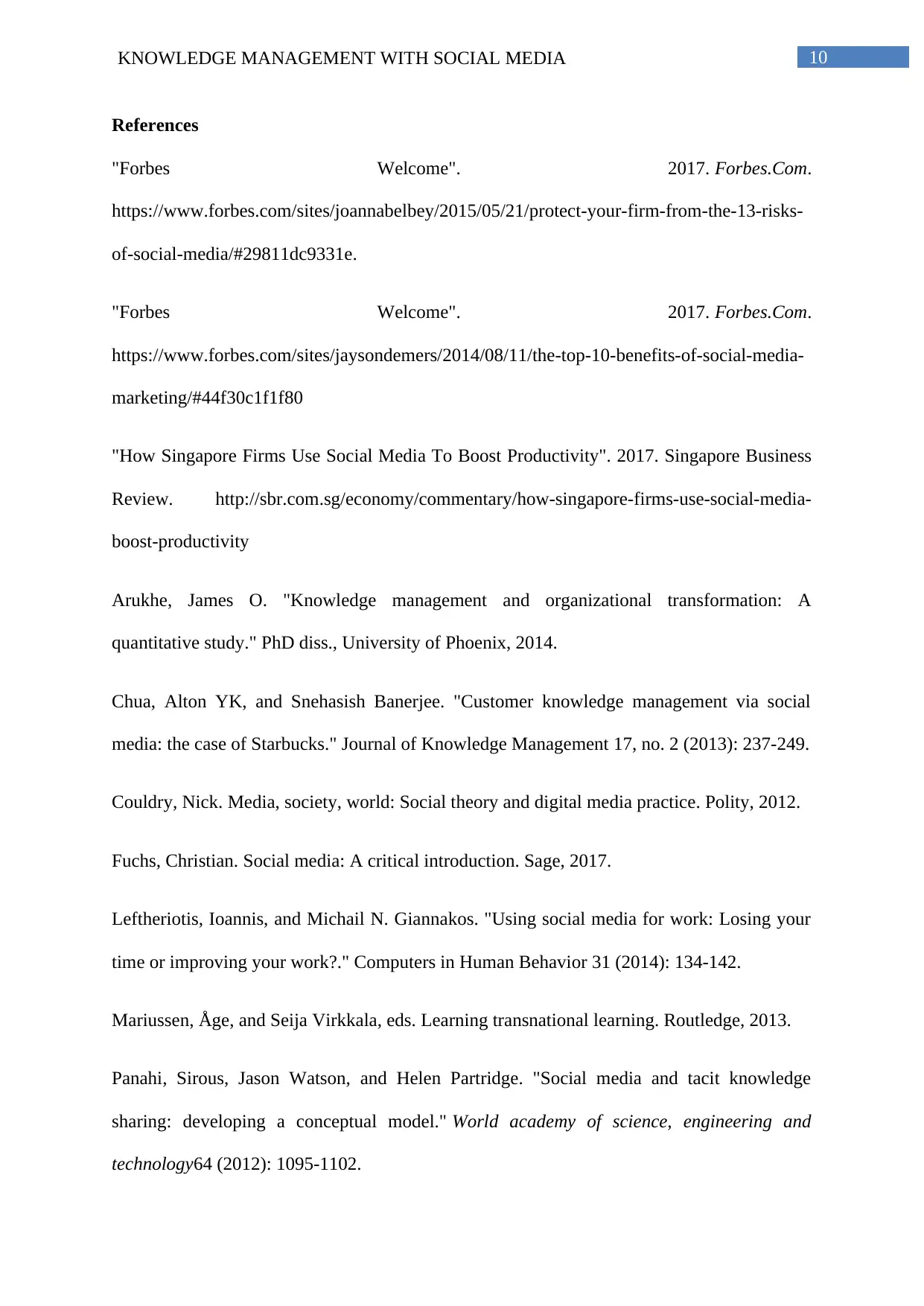
10KNOWLEDGE MANAGEMENT WITH SOCIAL MEDIA
References
"Forbes Welcome". 2017. Forbes.Com.
https://www.forbes.com/sites/joannabelbey/2015/05/21/protect-your-firm-from-the-13-risks-
of-social-media/#29811dc9331e.
"Forbes Welcome". 2017. Forbes.Com.
https://www.forbes.com/sites/jaysondemers/2014/08/11/the-top-10-benefits-of-social-media-
marketing/#44f30c1f1f80
"How Singapore Firms Use Social Media To Boost Productivity". 2017. Singapore Business
Review. http://sbr.com.sg/economy/commentary/how-singapore-firms-use-social-media-
boost-productivity
Arukhe, James O. "Knowledge management and organizational transformation: A
quantitative study." PhD diss., University of Phoenix, 2014.
Chua, Alton YK, and Snehasish Banerjee. "Customer knowledge management via social
media: the case of Starbucks." Journal of Knowledge Management 17, no. 2 (2013): 237-249.
Couldry, Nick. Media, society, world: Social theory and digital media practice. Polity, 2012.
Fuchs, Christian. Social media: A critical introduction. Sage, 2017.
Leftheriotis, Ioannis, and Michail N. Giannakos. "Using social media for work: Losing your
time or improving your work?." Computers in Human Behavior 31 (2014): 134-142.
Mariussen, Åge, and Seija Virkkala, eds. Learning transnational learning. Routledge, 2013.
Panahi, Sirous, Jason Watson, and Helen Partridge. "Social media and tacit knowledge
sharing: developing a conceptual model." World academy of science, engineering and
technology64 (2012): 1095-1102.
References
"Forbes Welcome". 2017. Forbes.Com.
https://www.forbes.com/sites/joannabelbey/2015/05/21/protect-your-firm-from-the-13-risks-
of-social-media/#29811dc9331e.
"Forbes Welcome". 2017. Forbes.Com.
https://www.forbes.com/sites/jaysondemers/2014/08/11/the-top-10-benefits-of-social-media-
marketing/#44f30c1f1f80
"How Singapore Firms Use Social Media To Boost Productivity". 2017. Singapore Business
Review. http://sbr.com.sg/economy/commentary/how-singapore-firms-use-social-media-
boost-productivity
Arukhe, James O. "Knowledge management and organizational transformation: A
quantitative study." PhD diss., University of Phoenix, 2014.
Chua, Alton YK, and Snehasish Banerjee. "Customer knowledge management via social
media: the case of Starbucks." Journal of Knowledge Management 17, no. 2 (2013): 237-249.
Couldry, Nick. Media, society, world: Social theory and digital media practice. Polity, 2012.
Fuchs, Christian. Social media: A critical introduction. Sage, 2017.
Leftheriotis, Ioannis, and Michail N. Giannakos. "Using social media for work: Losing your
time or improving your work?." Computers in Human Behavior 31 (2014): 134-142.
Mariussen, Åge, and Seija Virkkala, eds. Learning transnational learning. Routledge, 2013.
Panahi, Sirous, Jason Watson, and Helen Partridge. "Social media and tacit knowledge
sharing: developing a conceptual model." World academy of science, engineering and
technology64 (2012): 1095-1102.
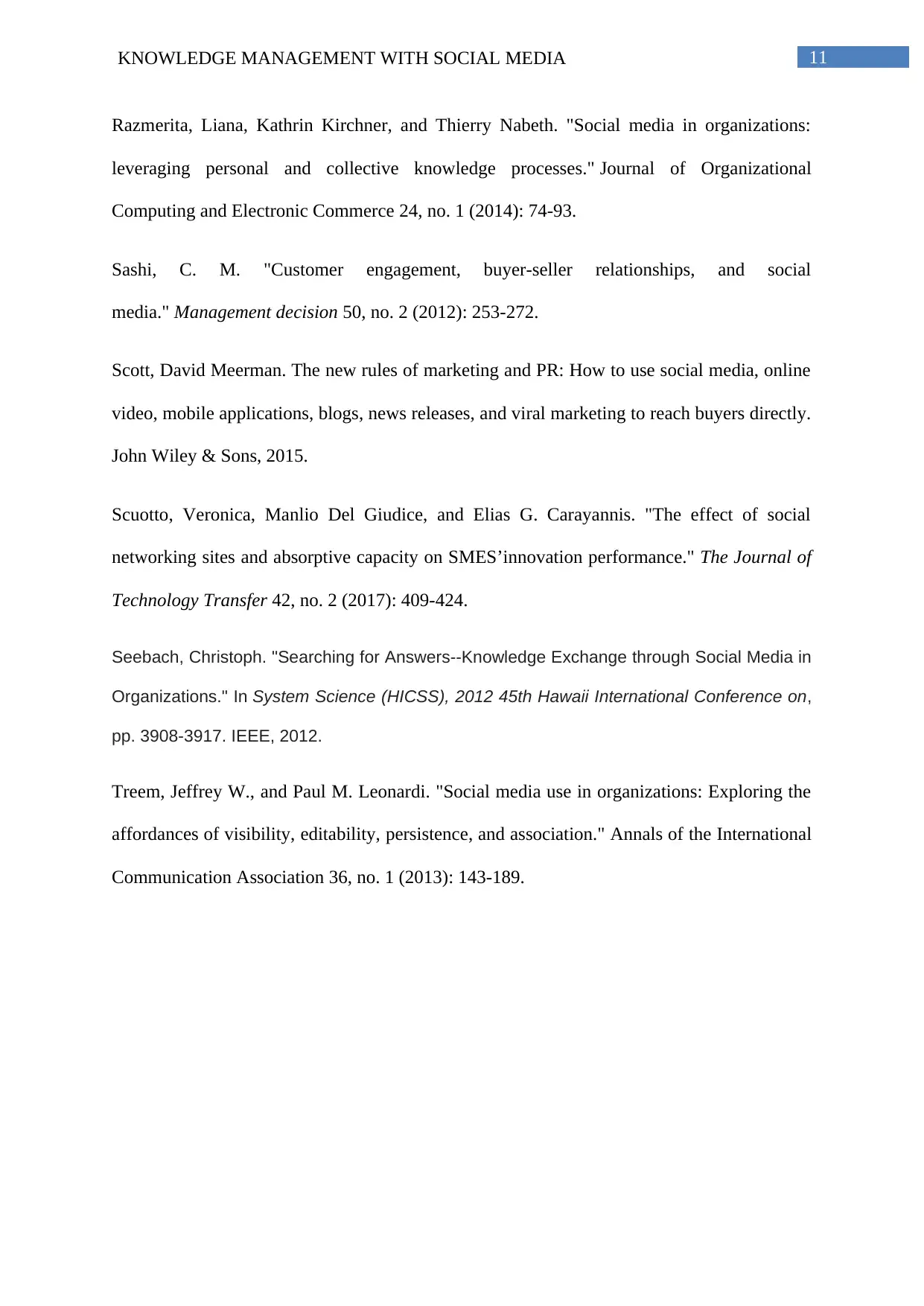
11KNOWLEDGE MANAGEMENT WITH SOCIAL MEDIA
Razmerita, Liana, Kathrin Kirchner, and Thierry Nabeth. "Social media in organizations:
leveraging personal and collective knowledge processes." Journal of Organizational
Computing and Electronic Commerce 24, no. 1 (2014): 74-93.
Sashi, C. M. "Customer engagement, buyer-seller relationships, and social
media." Management decision 50, no. 2 (2012): 253-272.
Scott, David Meerman. The new rules of marketing and PR: How to use social media, online
video, mobile applications, blogs, news releases, and viral marketing to reach buyers directly.
John Wiley & Sons, 2015.
Scuotto, Veronica, Manlio Del Giudice, and Elias G. Carayannis. "The effect of social
networking sites and absorptive capacity on SMES’innovation performance." The Journal of
Technology Transfer 42, no. 2 (2017): 409-424.
Seebach, Christoph. "Searching for Answers--Knowledge Exchange through Social Media in
Organizations." In System Science (HICSS), 2012 45th Hawaii International Conference on,
pp. 3908-3917. IEEE, 2012.
Treem, Jeffrey W., and Paul M. Leonardi. "Social media use in organizations: Exploring the
affordances of visibility, editability, persistence, and association." Annals of the International
Communication Association 36, no. 1 (2013): 143-189.
Razmerita, Liana, Kathrin Kirchner, and Thierry Nabeth. "Social media in organizations:
leveraging personal and collective knowledge processes." Journal of Organizational
Computing and Electronic Commerce 24, no. 1 (2014): 74-93.
Sashi, C. M. "Customer engagement, buyer-seller relationships, and social
media." Management decision 50, no. 2 (2012): 253-272.
Scott, David Meerman. The new rules of marketing and PR: How to use social media, online
video, mobile applications, blogs, news releases, and viral marketing to reach buyers directly.
John Wiley & Sons, 2015.
Scuotto, Veronica, Manlio Del Giudice, and Elias G. Carayannis. "The effect of social
networking sites and absorptive capacity on SMES’innovation performance." The Journal of
Technology Transfer 42, no. 2 (2017): 409-424.
Seebach, Christoph. "Searching for Answers--Knowledge Exchange through Social Media in
Organizations." In System Science (HICSS), 2012 45th Hawaii International Conference on,
pp. 3908-3917. IEEE, 2012.
Treem, Jeffrey W., and Paul M. Leonardi. "Social media use in organizations: Exploring the
affordances of visibility, editability, persistence, and association." Annals of the International
Communication Association 36, no. 1 (2013): 143-189.
⊘ This is a preview!⊘
Do you want full access?
Subscribe today to unlock all pages.

Trusted by 1+ million students worldwide
1 out of 13
Related Documents
Your All-in-One AI-Powered Toolkit for Academic Success.
+13062052269
info@desklib.com
Available 24*7 on WhatsApp / Email
![[object Object]](/_next/static/media/star-bottom.7253800d.svg)
Unlock your academic potential
Copyright © 2020–2025 A2Z Services. All Rights Reserved. Developed and managed by ZUCOL.




